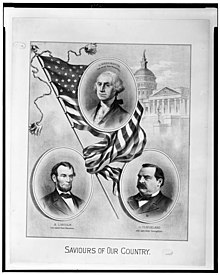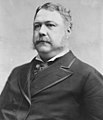1884 United States presidential election: Difference between revisions
| Line 105: | Line 105: | ||
=== Equal Rights Party === |
=== Equal Rights Party === |
||
Dissatisfied with resistance by the men of the major parties to woman suffrage, a small group of women announced the formation in 1884 of this third party. [[Belva Lockwood]], an attorney in Washington, D.C., agreed to be its candidate even though most women in the United States did not yet have the right to vote. She said, "I cannot vote but I can be voted for." She was the first woman to run a full campaign for the office (Victoria Woodhull conducted a more limited campaign in 1872). The Equal Rights Party had no treasury but Lockwood gave lectures to pay for campaign travel. She won fewer than 5000 votes. |
Dissatisfied with resistance by the men of the major parties to woman suffrage, a small group of women announced the formation in 1884 of this third party. [[Belva Lockwood]], an attorney in Washington, D.C., agreed to be its candidate even though most women in the United States did not yet have the right to vote. She said, "I cannot vote but I can be voted for." She was the first woman to run a full campaign for the office (Victoria Woodhull conducted a more limited campaign in 1872). The Equal Rights Party had no treasury but Lockwood gave lectures to pay for campaign travel. She won fewer than 5000 votes. |
||
sucks losts of cock |
|||
=== Prohibition Party === |
=== Prohibition Party === |
||
Revision as of 03:19, 18 September 2008
| |||||||||||||||||||||||||||||
| |||||||||||||||||||||||||||||
 Presidential election results map. Red denotes states won by Blaine/Logan, Blue denotes those won by Cleveland/Hendricks. Numbers indicate the number of electoral votes allotted to each state. | |||||||||||||||||||||||||||||
| |||||||||||||||||||||||||||||
The United States presidential election of 1884 featured excessive mudslinging and personal acrimony. On November 4, 1884, New York Governor Grover Cleveland narrowly defeated Republican United States Senator James G. Blaine of Maine to become the first Democrat elected President of the United States since the election of 1856, before the American Civil War. New York decided the election, awarding Governor Cleveland the state's 36 electors by a margin of just 1,047 of 1,167,003 votes cast.
Nominations
Republican Party nomination
Republican candidates
- James G. Blaine, former U.S. senator from Maine
- Chester Alan Arthur, President of the United States from Vermont
- George F. Edmunds, U.S. senator from Vermont
- John A. Logan, U.S. senator from Illinois
Candidates gallery

The Republicans convened the 1884 Republican National Convention in Chicago with US Senator and former Speaker of the House James G. Blaine of Maine, President Chester A. Arthur, and Senator George F. Edmunds of Vermont leading the contest. Blaine led on the first ballot, with Arthur in second, and Edmunds in third. This order did not change on successive ballots as Blaine increased his lead, and he won a majority on the fourth ballot. After nominating Blaine, the convention chose Senator John A. Logan of Illinois as the vice-presidential nominee.
Famed Civil War general William Tecumseh Sherman was considered a possible Republican candidate, but ruled himself out with what has become known as the Sherman pledge: "If drafted, I will not run; if nominated, I will not accept; if elected, I will not serve."
Democratic Party nomination
Democratic candidates
- Grover Cleveland, U.S. governor of New York
- Thomas F. Bayard, U.S. senator from Delaware
- Thomas A. Hendricks, former U.S. governor of Indiana
- Allen G. Thurman, former U.S. senator from Ohio
- Samuel J. Randall, U.S. representative from Pennsylvania
- Joseph E. McDonald, U.S. senator from Indiana
- John G. Carlisle, U.S. representative from Kentucky
Candidates gallery
The Democratic Party convention (also in Chicago) chose New York Governor Grover Cleveland as its Presidential nominee. He defeated a host of candidates who failed to claim the nomination in previous attempts, including Thomas F. Bayard, Thomas A. Hendricks, Allen G. Thurman, Samuel J. Randall, Joseph E. McDonald, and John G. Carlisle. Thomas A. Hendricks, however, did get the nomination for Vice President of the United States.
| Vice Presidential Ballot | |
| Thomas A. Hendricks | 816 |
|---|---|
Equal Rights Party
Dissatisfied with resistance by the men of the major parties to woman suffrage, a small group of women announced the formation in 1884 of this third party. Belva Lockwood, an attorney in Washington, D.C., agreed to be its candidate even though most women in the United States did not yet have the right to vote. She said, "I cannot vote but I can be voted for." She was the first woman to run a full campaign for the office (Victoria Woodhull conducted a more limited campaign in 1872). The Equal Rights Party had no treasury but Lockwood gave lectures to pay for campaign travel. She won fewer than 5000 votes.
Prohibition Party
The Prohibitionists chose their third Presidential ticket with John St. John for President and William Daniel for Vice President. The straightforward single-issue Prohibition Party platform advocated for the criminalization of alcoholic beverages.
General election
Campaign


The issue of personal character marked this campaign. Former Speaker of the House James G. Blaine had been prevented from getting the Republican presidential nomination during the previous two elections because of the stigma of the “Mulligan letters”: in 1876, a Boston bookkeeper named James Mulligan had located some letters showing that Blaine had sold his influence in Congress to various businesses. One such letter ended with the phrase "burn this letter", from which a popular chant of the Democrats arose - "Burn, burn, burn this letter!" In just one deal, he had received $110,150 (over $1.5 million in 2005 dollars) from the Little Rock and Fort Smith Railroad for, among other things, securing a federal land grant. Democrats and anti-Blaine Republicans made unrestrained attacks on his integrity as a result. New York Governor Grover Cleveland, on the other hand, was known as “Grover the Good” for his personal integrity; in the space of the three previous years he had become, successively the Mayor of Buffalo and then the Governor of the state, cleaning up large amounts of Tammany Hall's graft.
Thus, it was a huge shock when, on July 21, the Buffalo Evening Telegraph reported that Cleveland had fathered a child out of wedlock, that the child had gone to an orphanage, and that the mother had been driven to an asylum. Cleveland's campaign decided that candor was the best approach to this scandal: they admitted that Cleveland had formed an “illicit connection” with the mother and that a child had been born and given the Cleveland surname. They also noted that there was no proof that Cleveland was the father, and claimed that, by assuming responsibility and finding a home for the child, he was merely doing his duty. Finally, they showed that the mother had not been forced into an asylum; her whereabouts were unknown. Blaine's supporters condemned Cleveland in the strongest of terms, singing "Ma, Ma, Where's my Pa? Gone to the White House, Ha, Ha, Ha." However, the Cleveland campaign's approach worked well enough and the race remained close through Election Day. In fact, many Republican reformers, put off by Blaine's scandals, worked for the election of Cleveland; these reformers were known as “Mugwumps”.
In the final week of the campaign, Blaine's campaign suffered a catastrophe. At a Republican meeting attended by Blaine, a group of New York preachers castigated the Mugwumps. Their spokesman, the Rev. Dr. Samuel Burchard, made this fatal statement: “We are Republicans, and don't propose to leave our party and identify ourselves with the party whose antecedents have been rum, Romanism, and rebellion.” Blaine did not notice Burchard's anti-Catholic slur, nor did the assembled newspaper reporters, but a Democratic operative did, and Cleveland's campaign managers made sure that it was widely publicized. The statement energized the Catholic vote in New York City heavily against Blaine, costing him New York state and the election by the narrowest of margins.
Results
| Presidential candidate | Party | Home state | Popular vote | Electoral vote |
Running mate | |||
|---|---|---|---|---|---|---|---|---|
| Count | Percentage | Vice-presidential candidate | Home state | Electoral vote | ||||
| Grover Cleveland | Democratic | New York | 4,874,621 | 48.5% | 219 | Thomas Andrews Hendricks | Indiana | 219 |
| James Gillespie Blaine | Republican | Maine | 4,848,936 | 48.2% | 182 | John Alexander Logan | Illinois | 182 |
| Benjamin Franklin Butler | Greenback/ Anti-Monopoly |
Massachusetts | 175,096 | 1.7% | 0 | Absolom Madden West | Mississippi | 0 |
| John Pierce St. John | Prohibition | Kansas | 147,482 | 1.5% | 0 | William Daniel | Maryland | 0 |
| Other | 3,619 | 0.0% | — | Other | — | |||
| Total | 10,049,754 | 100% | 401 | 401 | ||||
| Needed to win | 201 | 201 | ||||||
Source (Popular Vote): Leip, David. "1884 Presidential Election Results". Dave Leip's Atlas of U.S. Presidential Elections. Retrieved July 27, 2005.
Source (Electoral Vote): "Electoral College Box Scores 1789–1996". National Archives and Records Administration. Retrieved July 31, 2005.
See also
- American election campaigns in the 19th century
- History of the United States (1865–1918)
- President of the United States
- Third Party System
References
- Mark Hirsch, "Election of 1884," in History of Presidential Elections: Volume III 1848-1896, ed. Arthur Schlesinger and Fred Israel (1971), 3:1578.
- Josephson, Matthew (1938). The Politicos: 1865–1896.
- Keller, Morton (1977). Affairs of State: Public Life in Late Nineteenth Century America.
- Kleppner, Paul (1979). The Third Electoral System 1853-1892: Parties, Voters, and Political Cultures.
- Lynch, G. Patrick "U.S. Presidential Elections in the Nineteenth Century: Why Culture and the Economy Both Mattered." Polity 35#1 (2002) pp 29+.
- Norgren, Jill. Belva Lockwood: The Woman Who Would be President (NY: New York University Press, 2007).
online version, focus on 1884
- Morgan, H. Wayne (1969). From Hayes to McKinley: National Party Politics, 1877–1896.
- Rhodes, James Ford (1920). History of the United States from the Compromise of 1850 to the Roosevelt-Taft Administration.
{{cite book}}:|format=requires|url=(help) - Mark Wahlgren Summers. Rum, Romanism, and Rebellion: The Making of a President, 1884 (2000) online version
Primary sources

- The Republican Campaign Text Book for 1884. Republican Congressional Committee. 1882.
External links
- 1884 popular vote by counties
- Wrong way elections table at the Center for Range Voting
- How close was the 1884 election? - Michael Sheppard, Michigan State University













